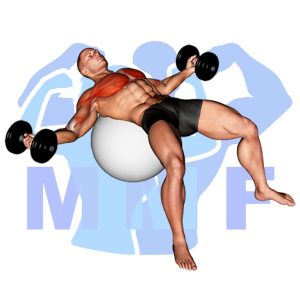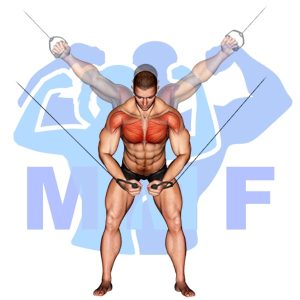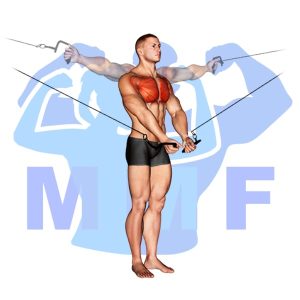If you are someone who struggles with maximizing the effectiveness of your chest workout, you are not alone. Many people turn to the low cable fly exercise to help them, but often find themselves not getting the results they desire. The common cause of this issue is performing the exercise incorrectly and not targeting the intended muscles. However, don’t let this discourage you! By the end of this post, you will have a comprehensive understanding of how to properly execute the low cable fly, to ensure that you are getting the most out of each repetition and seeing the results you have been striving for.
Low Cable Fly Summary
- Primary Muscles: Pectoralis Major – Sternal
- Secondary Muscles: Latissimus Dorsi, Levator Scapulae, Pectoralis Major – Clavicular, Pectoralis Minor, and Rhomboids
- Equipment: Cable Machine with Two Single D-Handles
- Mechanics Type: Isolated
- Force: Push
- Utility: Auxiliary

Low Cable Fly Instructions
- First, attach handles to pulleys opposite each other and set them parallel to your chest.
- Then, seize a grip in each hand while standing between the pulleys.
- Keep your torso upright, bend your elbows slightly while internally rotating your shoulders with your palms facing slightly down.
- Next, pull the grips together in front of you down toward your hips, maintaining your elbows fixed.
- Finally, allow the handles to pull your hands back up and out to the side.
- Repeat for these low cable flys for a full set.
Video Tutorial
Low Cable Fly Muscles
Target (Agonist)
- Pectoralis Major – Sternal
Synergists
- Latissimus Dorsi
- Levator Scapulae
- Pectoralis Major – Clavicular
- Pectoralis Minor
- Rhomboids
Dynamic Stabilizers
- None
Stabilizers
- Latissimus Dorsi
- Teres Major
- Pectoralis Major – Sternal
- Pectoralis Minor
- Rhomboids
- Levator Scapulae
- Trapezius – Lower
- Triceps – Long Head
- Brachialis
- Brachioradialis
- Biceps Brachii
Antagonist Stabilizers

Benefits of Low Cable Fly
The low cable fly is an excellent exercise to target the pectoralis major – sternal muscle. This exercise helps to strengthen the chest muscles, allowing you to lift heavier weights and increase your strength. Additionally, the low cable fly helps to improve posture and stabilize the shoulder blades. As you perform this exercise, you can focus on contracting and squeezing your chest muscles, which will help to increase their size and definition. Furthermore, performing this exercise will help to increase your overall strength and muscle endurance, as well as improve your core stability.
Tips for Performing Low Cable Fly
You’ve come at the right location if you desire to forge ahead your capability to perform low cable fly. Using these tips can allow you to take full advantage of this effective exercise. You will develop your chest muscles, and even reduce your chances of developing an injury. Let’s start now and see what these tips may achieve for you.
- Keep your back straight: Keeping your back straight during the exercise helps you to engage your chest and arm muscles, while also preventing injury.
- Start slow: Starting slowly allows you to maintain proper form throughout the exercise and gradually increase the weight you are using.
- Focus on the contraction: Concentrating on the contraction of your chest and arm muscles throughout the exercise will ensure that you are getting the most out of the exercise and achieving optimal results.
Benefits and Tips Video
Frequent Mistakes To Avoid
Avoiding common mistakes can be the distinction between a productive training session and a painful injury when performing low cable fly. Moreover, achieving the most out of the exercise requires proper form, and avoiding make any typical errors can allow you to perform the exercise correctly and obtain optimal results. However, take it easy, it’s not as challenging as it might seem. By knowing the mistakes to avoid and taking the appropriate actions, you may complete the activity securely and successfully. Thus, it is now your turn to maximize your results from this exercise and enjoy the benefits of a productive workout.
- Not starting with a light weight: Starting with a weight that is too heavy can cause injury and can prevent the user from completing the exercise correctly.
- Not maintaining proper form: Poor form can cause injury, reduce effectiveness of the exercise, and prevent the user from achieving desired results.
- Not taking sufficient rest between sets: Taking insufficient rest between sets can reduce the effectiveness of the exercise and can lead to fatigue and potential injury.
Find More Cable Exercises Here
Variations and Complementary Exercises
The Low Cable Fly is a great exercise for building strength and stability in your chest, shoulders, and arms. However, it is always beneficial to mix up your routine with different exercises. Below is a list of variations, complementary, or alternative exercises that work similar muscles as the Low Cable Fly.
Lying Cable Flys

Lying Cable Flys is an exercise that is complementary to Low Cable Flys, but can also be used as an alternative exercise. It is performed by lying on a flat bench and holding two cables in each hand. The arms are then extended out to the side while keeping the elbows slightly bent, and then the arms are brought together in a hugging motion. This exercise mainly targets the chest muscles, but it also works the shoulders and triceps. Compared to Low Cable Flys, Lying Cable Flys allow for a greater range of motion and more intense contraction of the target muscles.
Stability Ball Cable Flys

Stability Ball Cable Flys are a great complementary or alternative exercise to the Low Cable Fly. This exercise can be done on a stability ball and incorporates both upper and lower body muscles. It is an excellent option for those who want to add more range of motion to their chest and shoulder exercises. With this exercise, you will not only build strength, but also stability and balance. Furthermore, it can help to reduce the risk of injury by allowing for a greater range of motion and stability during the movement.
Stability Ball Dumbbell Fly

The Stability Ball Dumbbell Fly is a great complementary or alternative exercise to the Low Cable Fly. This exercise helps to target the same muscle groups, while also requiring more stabilizing muscles to be activated. It is performed by lying on a stability ball, holding two dumbbells with arms extended above the chest and chest slightly off the ball. The arms are then slowly lowered out to the sides, maintaining the slight arch in the back. The dumbbells are then brought back up to the starting position. This exercise helps to strengthen and tone the chest, shoulders, and triceps, making it an excellent alternative or complementary exercise for the Low Cable Fly.
Check Out These Top Cable Exercises
Stability Ball Incline Dumbbell Fly

The stability ball incline dumbbell fly is a great complementary exercise to the low cable fly, as it works the same muscles in a slightly different way. It is also a great alternative for those who do not have access to a cable machine. This exercise is performed by lying on an incline bench with a stability ball between the back and the bench and holding a pair of dumbbells in each hand. You then raise your arms out to the side, keeping them slightly bent, and lower them back down until they are level with your chest. This exercise is great for working the chest, shoulders and triceps.
Cable Crossover Flys

Cable Crossover Flys are an excellent alternative or complementary exercise to the Low Cable Fly. This exercise targets the chest muscles and works to build strength, stability, and control. It is performed by standing in the middle of two low pulleys, with arms bent and extended outward, and gripping each cable handle. The movement involves bringing the cables together in front of the body and squeezing the chest muscles as you exhale. As you inhale, slowly lower the arms back to the starting position. This exercise can be performed with a lighter weight to focus on building muscle control and stability, or heavier weights for more strength-building.
Cable Decline Fly

The Cable Decline Fly is a great complementary or alternative exercise for the Low Cable Fly. It requires the user to be seated, typically on a decline bench, and hold a handle attached to a low cable pulley. With the arms extended, the user then brings the handles together in front of their body, similar to the Low Cable Fly. This exercise emphasizes the upper chest muscles and is great for strengthening the pectoral muscles. It can also be used as an alternative exercise to target the same muscles as the Low Cable Fly, but with more range of motion.
Find More Chest Exercises Here
Opposing Complementary Exercises
The Low Cable Fly is an effective exercise for strengthening the pectoral muscles, but it’s important to strengthen the opposing muscle groups as well. To ensure balanced muscular development and stability, you should include these exercises in your routine:
Cable Rope Face Pull

The Cable Rope Face Pull is a great complementary exercise to the Low Cable Fly because it targets the opposing muscle group. The Cable Rope Face Pull focuses on the muscles of the upper back, while the Low Cable Fly works the chest muscles. The two exercises together can help create a balanced physique and strong core. The Cable Rope Face Pull also helps to improve posture by strengthening the muscles of the upper back, which can help reduce any aches and pains that come from poor posture. Additionally, the Cable Rope Face Pull helps to improve shoulder mobility by increasing range of motion and flexibility.
Dumbbell One Arm Rear Deltoid Row

The Dumbbell One Arm Rear Deltoid Row is a great exercise to complement the Low Cable Fly. This exercise focuses on strengthening the rear deltoids, which are the opposing muscle group to the chest muscles used in the Low Cable Fly. By strengthening the rear deltoids, you will be able to better stabilize your shoulder joint and reduce the risk of injury. Additionally, this exercise will help to create a balanced upper body look by developing both the front and back of the shoulders.
Dumbbell Rear Deltoid Raise

The Dumbbell Rear Deltoid Raise is the perfect complement to the Low Cable Fly exercise. By targeting the rear deltoid muscles, it helps to create a balanced muscle development between the anterior and posterior shoulder muscles. The Low Cable Fly works the anterior deltoid muscles, while the Dumbbell Rear Deltoid Raise targets the rear deltoids. This ensures that all muscle groups in the shoulder are worked and developed evenly, allowing for a more balanced physique.
Fly High: Sculpt Your Chest with Low Cable Fly!
Looking for a good way to tone your chest muscles? Then consider the low cable fly! This exercise is a great way to build strength and definition in your chest while also working your shoulders, arms, and core. By keeping your form strict and maintaining a controlled tempo, you can ensure that each rep is effective and helps you move closer towards your fitness goals. So if you’re ready to sculpt your chest and feel the burn, give the low cable fly a try during your next workout!
References: Wikipedia | ExRx.net | PubMed.gov | Comprehensive List of Chest Cable Exercises




